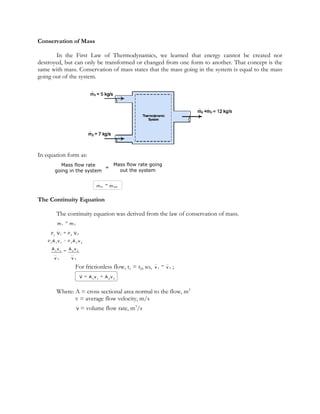
Bernoulli's equation
- 1. Conservation of Mass In the First Law of Thermodynamics, we learned that energy cannot be created nor destroyed, but can only be transformed or changed from one form to another. That concept is the same with mass. Conservation of mass states that the mass going in the system is equal to the mass going out of the system. In equation form as: Mass flow rate Mass flow rate going = going in the system out the system . . m in m out The Continuity Equation The continuity equation was derived from the law of conservation of mass. . . m1 m2 . . 1 V1 2 V2 1 A 1v 1 2 A 2v 2 A 1v 1 A 2v 2 __ __ v1 v2 __ __ For frictionless flow, t1 = t2, so, v1 v2 ; . V A 1v 1 A 2v2 Where: A = cross sectional area normal to the flow, m2 v = average flow velocity, m/s . V = volume flow rate, m3/s
- 2. The Bernoulli’s Principle Assumptions: 1. The flow is incompressible, therefore the specific weight of the fluid is constant. 2. The fluid is ideal or no viscosity is considered. 3. There are no mechanical devices such as pumps or turbines in between point 1 and point 2 of the system. 4. The flow is steady 5. No heat removed or added in between point 1 and point 2 of the system. Applying the Law of Conservation of Energy [E IN E OUT ] PE 1 KE 1 Wf1 U1 PE 2 KE 2 Wf2 U2 If we assume that the temperature from the suction and discharge of the pump are almost equal, t t , then we can say that the change in internal energy is negligible, 1 2 . . U 0 . We can also assume a steady state pumping process for the pump, V1 V2 . . . . go 1 mW 2 . . go 1 mW 2 . mW z1 v1 V W P1 mW z2 v2 V W P2 gC 2 gC gC 2 gC gC Multiplying both sides of the equations by . . m W go 2 2 1 v1 P1 1 v2 P2 z1 z2 2 gC W 2 gC W
- 3. Torricelli’s Theorem 2 2 1 v1 P1 1 v2 P2 z1 z2 2 gC W 2 gC W v 2 g oh